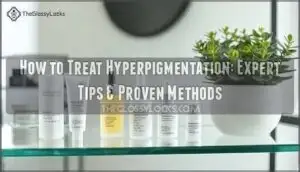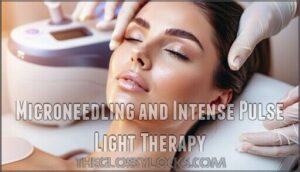This site is supported by our readers. We may earn a commission, at no cost to you, if you purchase through links.

First, shield your skin with broad-spectrum SPF 30+ sunscreen daily – it’s your strongest defense against further damage.
Next, incorporate proven lightening ingredients like vitamin C, retinoids, or hydroquinone into your routine.
These powerhouse compounds work overtime to fade existing spots and prevent new ones.
For faster results, consider professional treatments like chemical peels or laser therapy.
Consistency is key – most people see improvement within 6-12 weeks of dedicated treatment.
The right combination of protection, active ingredients, and patience yields clearer, more even-toned skin than you might expect.
Table Of Contents
- Key Takeaways
- Hyperpigmentation Basics
- Treating Hyperpigmentation
- Preventing Hyperpigmentation
- Advanced Treatment Options
- Managing Hyperpigmentation
- Frequently Asked Questions (FAQs)
- What is the best treatment for hyperpigmentation?
- How to diminish the appearance of hyperpigmentation?
- What are the side effects of treatment for hyperpigmentation?
- Can a dermatologist help with hyperpigmentation?
- What is the fastest way to heal hyperpigmentation?
- What is the fastest way to cure hyperpigmentation?
- What fades hyperpigmentation fast?
- Can hyperpigmentation go away?
- Which treatment is best for hyperpigmentation?
- How long does hyperpigmentation treatment take to show results?
- Conclusion
Key Takeaways
- You’ll protect your skin from further damage by using broad-spectrum SPF 30+ sunscreen daily, which prevents new dark spots while existing ones fade.
- You can fade stubborn spots faster with proven ingredients like vitamin C, retinoids, or hydroquinone that target excess melanin production.
- You’ll see faster results with professional treatments like chemical peels or laser therapy, which accelerate the fading process compared to at-home remedies.
- You need consistency and patience since most hyperpigmentation treatments take 6-12 weeks to show visible improvement, regardless of which method you choose.
Hyperpigmentation Basics
You’ll notice dark patches on your skin where sun exposure, hormonal changes, or inflammation have triggered excess melanin production.
These discolored areas commonly appear on your face, neck, arms, and hands, ranging from light brown to deep purple depending on your skin tone.
Definition and Causes
Hyperpigmentation occurs when your skin darkening results from excess melanin production in certain areas.
Sun exposure triggers this overproduction as your skin’s natural defense mechanism, while genetic factors determine your baseline susceptibility.
Hormonal changes, medications, and skin injuries also stimulate melanin synthesis, creating various hyperpigmentation types and skin discoloration patterns across different pigmentation levels.
Understanding the causes of skin darkening issues is essential for effective treatment and prevention of hyperpigmentation.
Common Areas Affected
Anyone can develop dark spots, but certain body areas bear the brunt of hyperpigmentation’s effects.
Face hyperpigmentation appears most frequently, followed by neck discoloration and chest marks from sun exposure.
Your hands show spots early since they’re constantly exposed, while shin darkening often develops in adults with darker skin tones.
These visible areas require targeted skin discoloration treatment approaches.
Types of Hyperpigmentation
Understanding different hyperpigmentation types helps you choose the right treatment approach.
Melasma creates symmetrical dark patches on your face, often triggered by hormones and sun exposure.
Post-inflammatory hyperpigmentation follows skin injuries like acne breakouts.
Solar lentigines (age spots) develop from cumulative sun damage, while freckles formation occurs earlier in life from genetic predisposition and UV exposure.
Treating Hyperpigmentation
Several effective treatments can restore your skin’s natural radiance and tackle stubborn dark spots. Hyperpigmentation treatment targets melanin reduction through proven methods that deliver visible results within weeks to months.
Four proven treatment approaches:
- Hyperpigmentation creams containing hydroquinone, kojic acid, or azelaic acid effectively lighten pigment masks by inhibiting melanin production
- Facial serums with vitamin C, niacinamide, and tranexamic acid provide targeted pigmentation reduction while brightening overall skin tone
- Skin exfoliants like alpha hydroxy acids and retinoids accelerate cell turnover, removing pigmented cells and promoting skin tone evening
- Combination therapy using multiple active ingredients together produces faster, more dramatic results than single treatments
Understanding hyperpigmentation causes helps you choose the right treatment approach. Post-inflammatory hyperpigmentation responds well to gentle exfoliation, while melasma requires stronger lightening agents. Consistency matters most – most treatments require 8-12 weeks of regular use before you’ll see significant improvement in your skin’s appearance.
Effective hyperpigmentation treatment options are essential for achieving desirable results and preventing further skin discoloration.
Preventing Hyperpigmentation
While treating hyperpigmentation is essential, prevention remains your most powerful tool against dark spots and uneven skin tone.
You’ll protect your skin’s natural complexion and avoid the frustration of lengthy treatment cycles by establishing proper prevention habits now.
Daily Sunscreen Use
Protecting your skin from further UV damage is your strongest defense against worsening hyperpigmentation.
Daily sunscreen application with broad spectrum SPF 30 prevents new dark spots from forming while existing ones fade.
Using the right sunscreen for hyperpigmentation is essential in this process.
| Application Time | SPF Recommendation | Reapplication Frequency |
|---|---|---|
| Morning routine | SPF 30 minimum | Every 2 hours |
| Before outdoor activities | SPF 50+ | After swimming/sweating |
| Year-round use | Broad spectrum | Daily, rain or shine |
Choosing The Right Sunscreen
Your sunscreen choice can make or break your hyperpigmentation battle. Look for broad-spectrum SPF 30 or higher with mineral blockers like zinc oxide and titanium dioxide.
These sunscreen types offer superior UV protection without irritating sensitive skin. Tinted formulas work well for all skin tones, providing extra visible light defense.
Choose lightweight gels for oily skin or creams for dry complexions to guarantee consistent application. When selecting a sunscreen, consider the importance of broad spectrum protection to effectively prevent hyperpigmentation.
Avoiding Peak Sun Hours
When UV rays peak between 10 a.m. and 4 p.m., your skin faces maximum sun damage risk.
Strategic timing transforms your Daily Habits into powerful UV Prevention shields:
- Schedule outdoor activities before 10 a.m.
- Seek shade during midday Peak Hours
- Plan errands for late afternoon
- Use UV index apps for real-time monitoring
- Combine timing with robust Sun Protection measures
This Skin Shielding approach reduces sun exposure substantially.
Advanced Treatment Options
When over-the-counter treatments aren’t enough, you’ll need more powerful professional options to tackle stubborn hyperpigmentation.
Dermatologists offer advanced procedures like chemical peels, laser therapies, and prescription-strength lightening creams that deliver faster, more dramatic results than home treatments.
Chemical Peels and Laser Therapies
Professional laser treatments and chemical peels offer your skin’s fastest route to freedom from stubborn dark spots.
Glycolic acid peels excel at breaking down postacne pigmentation, while picosecond lasers target deeper melasma with precision.
These skin resurfacing procedures accelerate hyperpigmentation removal through controlled exfoliation and cellular renewal, delivering facial rejuvenation results within weeks rather than months.
Effective laser skin treatment options are available for various skin concerns, including hyperpigmentation.
Microneedling and Intense Pulse Light Therapy
When conventional treatments fall short, microneedling and intense pulse light therapy offer powerful skin rejuvenation solutions.
These advanced facial resurfacing techniques target stubborn hyperpigmentation by stimulating natural collagen production and breaking down excess melanin deposits beneath your skin’s surface. Understanding skin aging processes is essential for effective treatment selection.
- Microneedling Benefits: Creates controlled micro-injuries that trigger your skin’s healing response, reducing skin pigmentation while improving overall texture
- Pulse Light Therapy: Uses targeted light energy for precise hyperpigmentation removal without damaging surrounding healthy tissue
- Combined Results: Both laser therapies work synergistically to accelerate cellular turnover and reveal clearer, more even-toned skin
Prescription Lightening Creams
When stubborn dark spots won’t budge, dermatologists bring out the heavy artillery: prescription lightening creams.
Hydroquinone cream remains the gold standard for skin bleaching, delivering results in up to 70% of patients.
Retinoid therapy and azelaic acid work alongside hydroquinone in powerful combination treatments, targeting melanin production at its source for effective hyperpigmentation treatment.
Managing Hyperpigmentation
Successfully managing hyperpigmentation requires a thorough approach that combines the right treatments with consistent daily habits.
Consistency beats intensity when battling dark spots—small daily steps create lasting change.
You’ll need to understand which methods work best for your specific type of discoloration and commit to a long-term skincare routine that protects your progress.
Lifestyle Changes and Home Remedies
Beyond professional treatments, you can take control through simple lifestyle shifts.
Dietary adjustments rich in vitamin C and omega-3s reduce inflammation while cutting sugar prevents new dark spots.
Natural remedies like aloe vera and turmeric masks offer gentle skin brightening.
Stress management through meditation and proper sleep patterns support cellular repair, making your skin care routine more effective against hyperpigmentation.
Over-the-Counter Topical Remedies
Over-the-counter treatments offer powerful options for tackling hyperpigmentation at home.
These topical treatments contain proven ingredients that target skin lightening through different mechanisms.
Key OTC ingredients include:
- Face Acids – Alpha hydroxy acids and salicylic acid exfoliate pigmented cells
- Topical Retinoids – Boost cell turnover to fade dark spots gradually
- Lightening Creams – Hydroquinone (2%) and kojic acid inhibit melanin production
- Skin Exfoliants – Remove surface pigmentation for brighter, even-toned skin
Effective hyperpigmentation treatment often involves using a hyperpigmentation cream to achieve desirable results.
Consulting a Dermatologist for Professional Help
When over-the-counter treatments don’t deliver results you’re seeking, a dermatologist consultation becomes your next strategic move.
Professional skin analysis provides accurate hyperpigmentation diagnosis and personalized treatment options. Your dermatologist can recommend prescription lightening agents, advanced procedures, or combination therapies based on your specific skin care needs and pigmentation severity.
Effective hyperpigmentation treatment often involves understanding skin hyperpigmentation causes and prevention methods.
Frequently Asked Questions (FAQs)
What is the best treatment for hyperpigmentation?
Tired of dark spots ruining your confidence? Hydroquinone remains the gold standard treatment, but you’ll also find success with retinoids, vitamin C, and chemical peels for faster results.
How to diminish the appearance of hyperpigmentation?
You can diminish hyperpigmentation by using products with vitamin C, kojic acid, or retinoids daily. Apply sunscreen religiously to prevent worsening. Consider professional chemical peels for faster results.
What are the side effects of treatment for hyperpigmentation?
Ironically, treatments meant to brighten your skin can darken it further. You’ll face sun sensitivity, irritation, redness, and potential scarring from chemical peels. Hydroquinone may cause unwanted skin bleaching.
Can a dermatologist help with hyperpigmentation?
Yes, a dermatologist can effectively help with hyperpigmentation.
They’ll prescribe stronger treatments like hydroquinone, tretinoin, or combination therapies, plus perform professional procedures like chemical peels for faster, more dramatic results than over-the-counter options, yielding faster results.
What is the fastest way to heal hyperpigmentation?
Professional treatments like chemical peels, laser therapy, and prescription hydroquinone deliver the fastest results. You’ll see improvement within 4-6 weeks, but consistency with dermatologist-recommended treatments accelerates healing substantially.
What is the fastest way to cure hyperpigmentation?
You can’t technically "cure" hyperpigmentation since it’s often chronic, but prescription hydroquinone combined with tretinoin delivers the fastest results.
Professional chemical peels accelerate improvement, showing visible changes within weeks rather than months, using tretinoin.
What fades hyperpigmentation fast?
Prescription tretinoin, hydroquinone creams, and professional chemical peels deliver fastest results. You’ll see noticeable fading in 6-8 weeks with consistent use and strict sun protection.
Can hyperpigmentation go away?
Hyperpigmentation can fade naturally over time, but it won’t disappear completely without treatment. You’ll see better results combining consistent skincare with professional treatments for faster improvement.
Which treatment is best for hyperpigmentation?
Clinical studies show 79% of patients see improved skin tone after 12 weeks with combination treatments.
You’ll get best results pairing hydroquinone with tretinoin and gentle exfoliation—this triple threat tackles pigmentation from multiple angles simultaneously, using a triple threat approach.
How long does hyperpigmentation treatment take to show results?
You’ll typically see initial improvements in 4-6 weeks with consistent treatment.
Over-the-counter products take 8-12 weeks for noticeable results, while prescription treatments work faster, showing changes in 6-8 weeks for ideal outcomes.
Conclusion
Like peeling an onion layer by layer, how to treat hyperpigmentation requires patience and persistence.
You’ve learned that consistent daily sunscreen application forms your foundation, while targeted ingredients like vitamin C and retinoids work to fade existing spots.
Professional treatments can accelerate results, but remember that visible improvement typically takes 6-12 weeks.
Stick with your chosen routine, protect your skin religiously, and consult a dermatologist when needed for ideal results.
- https://pmc.ncbi.nlm.nih.gov/articles/PMC9165630/
- https://www.health.harvard.edu/diseases-and-conditions/demystifying-hyperpigmentation-causes-types-and-effective-treatments
- https://www.bellairedermatology.com/blog/professional-treatments-for-hyperpigmentation-options-and-results/
- https://thedermgrouppartners.com/does-laser-treatment-work-permanently-for-pigmentation/
- https://www.medicalnewstoday.com/articles/325920








